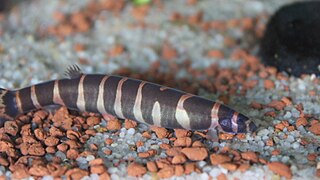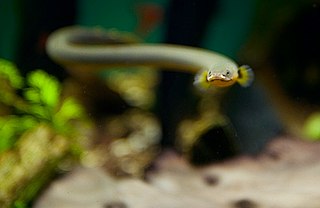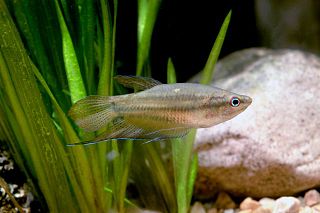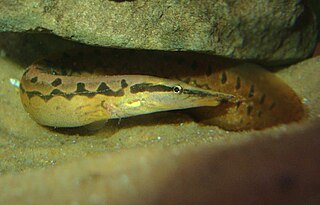
Cobitidae, also known as the True loaches, is a family of Old World freshwater fish. They occur throughout Eurasia and in Morocco, and inhabit riverine ecosystems. Today, most "loaches" are placed in other families. The family includes about 260 described species. New species are being described regularly.

Heinrich Kuhl was a German naturalist and zoologist.

Pangio is a genus of small Asian freshwater fish in the true loach family Cobitidae. In earlier taxonomic schemes it was known as Acanthophthalmus. The "kuhli loach" is well-known in the aquarium trade and commonly identified as P. kuhlii, but most individuals actually appear to be P. semicincta.

The clown loach, or tiger botia, is a tropical freshwater fish belonging to the botiid loach family. It is the sole member of the genus Chromobotia. It originates in inland waters in Indonesia on the islands of Sumatra and Borneo. In Sentarum, West Borneo that fish named: ulanguli. It is a popular fish in the freshwater aquarium trade and is sold worldwide.

The reedfish, ropefish, or snakefish, Erpetoichthys calabaricus, is a species of fish in the bichir family and order. It is the only member of the genus Erpetoichthys. It is native to fresh and brackish waters in West and Central Africa. The reedfish possesses a pair of lungs in addition to gills, allowing it to survive in very oxygen-poor water. It is threatened by habitat loss through palm oil plantations, other agriculture, deforestation, and urban development.

The pond loach, also known as the Dojo loach, oriental weatherloach or oriental weatherfish, is a freshwater fish in the loach family Cobitidae. They are native to East Asia but are also popular as an aquarium fish and introduced elsewhere in Asia and to Europe, America and Australia. The alternate name weather loach is shared with several other Cobitidae, including the other members of the genus Misgurnus and the spotted weather loach. This term comes from their ability to detect changes in barometric pressure and react with frantic swimming or standing on end. This is because before a storm the barometric pressure changes, and this is known to make these fish more active. The pond loach also comes in a variety of colors, such as pink, orange, albino and gray.

The croaking gourami is a species of small freshwater labyrinth fish of the gourami family. They are native to still waters in Southeast Asia and are distributed worldwide via the aquarium trade. Croaking gouramis are capable of producing a "croaking" noise using their pectoral fins.

Corydoras panda is a species of catfish belonging to the genus Corydoras, of the family Callichthyidae, and is a native member of the riverine fauna of South America. It is found in Peru and Ecuador, most notably in the Huanaco region, where it inhabits the Rio Aquas, the Rio Amarillae, a tributary of the Rio Pachitea, and the Rio Ucayali river system. The species was first collected by Randolph H. Richards in 1968, and was named Corydoras panda by Nijssen and Isbrücker in 1971. The specific name is an allusion to the appearance of the fish, which possesses large black patches surrounding the eyes, reminiscent of those found on the giant panda. Accordingly, the common names for this fish, which is a popular aquarium species, are panda corydoras and panda catfish.

Mikrogeophagus altispinosus is a species of fish endemic to the Amazon River basin in Brazil and Bolivia. The species is part of the family Cichlidae and subfamily Geophaginae. It is a popular aquarium fish, traded under the common names Bolivian butterfly, Bolivian ram, Bolivian ram cichlid, and ruby crown cichlid.

The zig-zag eel, also known as the tire-track eel, tire-track spiny eel or marbled spiny eel, is a species of ray-finned, spiny eels belonging to the genus Mastacembelus of the family Mastacembelidae, and is native to the riverine fauna of India, Bangladesh, Pakistan, Sri Lanka, Thailand, Vietnam, Indonesia and other parts of Southeast Asia. The species was described as Macrognathus armatus by Lacepède in 1800. Other common names for this popular aquarium species are leopard spiny eel and white-spotted spiny eel. This species is not only a popular aquarium fish but also as a food fish in its country of origin.

The stone loach is a European species of fresh water ray-finned fish in the family Nemacheilidae. It is one of nineteen species in the genus Barbatula. Stone loaches live amongst the gravel and stones of fast flowing water where they can search for food. The most distinctive feature of this small fish is the presence of barbels around the bottom jaw, which they use to detect their invertebrate prey. The body is a mixture of brown, green and yellow.
Pangio anguillaris is a species of loach found in still and slow-moving freshwater in Indochina, Malay Peninsula, Sumatra, and Borneo.

Yasuhikotakia modesta is a tropical freshwater fish of the family Botiidae. It is native to large rivers in Thailand, Laos, Cambodia, and Vietnam. The blue botia is a widely available fish in the aquarium trade and can be purchased globally.

The Java loach (Pangio oblonga) is a species of tropical freshwater fish, an unbanded kuhli loach, native to the sandy streams of Southeast Asia. Its alternative common names include the black kuhli (loach), chocolate kuhli and cinnamon loach. It is common in the aquarium trade.

Pangio myersi is a species of loach in the genus Pangio native to Laos, Cambodia, Viet Nam and Thailand. They are black with orange bands, and can grow to 10 centimetres (3.9 in) SL.

Pangio semicincta the Half-Banded Kuhli Loach is a species of cobitid loach in the genus Pangio found in the Malay Peninsula, Borneo, and Sumatra. It is a very popular fish in the aquarium trade, however it is often confused for and mislabeled as Pangio kuhlii, which is rarely if ever found in the aquarium trade due to it being endemic to Java and Sumatera in Indonesia, where collection for the fish trade is rare.

Toxotes chatareus, sometimes known by the common names common archerfish, seven-spot archerfish or largescale archerfish, is a species of perciform fish in the archerfish genus Toxotes.

Gyrinocheilus aymonieri is a freshwater fish native to large parts of Southeast Asia. It is of interest as a local food source and for the aquarium trade. Its common names include honey sucker, sucking loach and Chinese algae eater.

Loaches are fish of the superfamily Cobitoidea. They are freshwater, benthic (bottom-dwelling) fish found in rivers and creeks throughout Eurasia and northern Africa. Loaches are among the most diverse groups of fish; the 1249 known species of Cobitoidea comprise about 107 genera divided among 9 families.

Syncrossus helodes, commonly known as banded loach, tiger botia or lesser katy loach, is a freshwater fish in the loach family Botiidae. It is native to rivers in Vietnam, Thailand, Laos and Cambodia. S. helodes resembles S. hymenophysa from Borneo, Sumatra and Peninsular Malaysia, and the two have frequently been confused. It differs from the latter species by the absence of a dark spot on the dorsal fin, 10–12 bars on body without blue borders and the presence of irregular dark markings on the lower body.




















